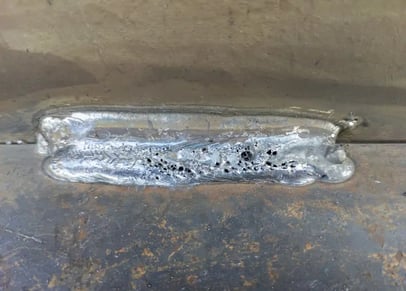What is Porosity in Welding: Common Resources and Effective Solutions
What is Porosity in Welding: Common Resources and Effective Solutions
Blog Article
The Science Behind Porosity: A Comprehensive Overview for Welders and Fabricators
Understanding the elaborate systems behind porosity in welding is crucial for welders and producers striving for impeccable craftsmanship. From the make-up of the base materials to the intricacies of the welding procedure itself, a wide range of variables conspire to either exacerbate or minimize the existence of porosity.
Comprehending Porosity in Welding
FIRST SENTENCE:
Examination of porosity in welding discloses vital understandings into the integrity and top quality of the weld joint. Porosity, characterized by the visibility of dental caries or voids within the weld metal, is a common concern in welding procedures. These voids, otherwise appropriately dealt with, can jeopardize the architectural honesty and mechanical residential properties of the weld, leading to prospective failures in the ended up product.

To spot and quantify porosity, non-destructive screening methods such as ultrasonic screening or X-ray assessment are usually utilized. These techniques enable the recognition of inner defects without jeopardizing the integrity of the weld. By assessing the dimension, form, and distribution of porosity within a weld, welders can make informed choices to enhance their welding processes and achieve sounder weld joints.

Variables Affecting Porosity Formation
The occurrence of porosity in welding is affected by a myriad of variables, varying from gas shielding efficiency to the complexities of welding criterion setups. One crucial aspect adding to porosity formation is inadequate gas protecting. When the protecting gas, usually argon or carbon dioxide, is not properly covering the weld pool, climatic gases like oxygen and nitrogen can contaminate the liquified steel, bring about porosity. Additionally, the sanitation of the base materials plays a considerable role. Contaminants such as rust, oil, or moisture can vaporize throughout welding, creating gas pockets within the weld. Welding specifications, including voltage, current, travel rate, and electrode kind, likewise impact porosity formation. Utilizing inappropriate setups can generate excessive spatter or heat input, which subsequently can lead to porosity. The welding technique employed, such as gas steel arc welding (GMAW) or protected steel arc welding (SMAW), can affect porosity formation due to variants in heat circulation and gas protection. Recognizing and controlling these factors are important for decreasing porosity in welding operations.
Results of Porosity on Weld Quality
Porosity development substantially endangers the structural honesty and mechanical properties of bonded joints. When porosity is present in a weld, it produces voids or cavities within the product, reducing the general stamina of the joint. These spaces act as stress and anxiety concentration points, making the weld more vulnerable to splitting and failing under load. The existence of porosity likewise weakens the weld's resistance to corrosion, as the entraped air or gases within the spaces can respond with check over here the surrounding atmosphere, leading to destruction in time. Furthermore, porosity can impede the weld's capacity to stand up to stress or effect, further jeopardizing the total quality and dependability of the bonded framework. In crucial applications such as aerospace, vehicle, or architectural buildings, where security and toughness are paramount, the destructive results of porosity on weld high quality can have extreme repercussions, highlighting the relevance of minimizing porosity via proper welding strategies and treatments.
Methods to Minimize Porosity
Furthermore, making use of the ideal welding specifications, such as the right voltage, existing, and take a trip rate, is essential in avoiding porosity. Maintaining a consistent arc size and angle during welding likewise aids reduce the possibility of porosity.

In addition, selecting the right protecting gas and preserving correct gas circulation rates are necessary in lessening porosity. Making use of the suitable welding method, such as back-stepping or using a weaving movement, can also help disperse warm evenly and minimize the possibilities of porosity formation. Making sure correct air flow in the welding environment to remove any kind of prospective resources of contamination is Full Report vital for attaining porosity-free welds. By applying these strategies, welders can properly decrease porosity and create premium bonded joints.

Advanced Solutions for Porosity Control
Carrying out advanced technologies and cutting-edge techniques plays an essential role in attaining exceptional control over porosity in welding procedures. One innovative remedy is using sophisticated gas mixtures. Securing gases like helium or a mixture of argon and hydrogen can aid decrease porosity by giving much better arc stability and improved gas coverage. In addition, using advanced welding strategies such as pulsed MIG welding or customized environment welding can additionally help alleviate porosity problems.
An additional sophisticated service entails using sophisticated welding look these up tools. As an example, making use of equipment with integrated features like waveform control and innovative power resources can enhance weld top quality and decrease porosity risks. The application of automated welding systems with precise control over parameters can significantly minimize porosity defects.
In addition, integrating sophisticated surveillance and assessment innovations such as real-time X-ray imaging or automated ultrasonic screening can aid in detecting porosity early in the welding procedure, permitting immediate restorative actions. Overall, integrating these innovative remedies can significantly improve porosity control and improve the overall top quality of welded parts.
Verdict
In conclusion, understanding the science behind porosity in welding is essential for welders and makers to produce high-grade welds - What is Porosity. Advanced services for porosity control can additionally boost the welding procedure and guarantee a strong and trustworthy weld.
Report this page